Abstract
Down syndrome (DS) is a major cause of mental retardation and heart disease. Although it is usually caused by the presence of an extra chromosome 21, a subset of the diagnostic features may be caused by the presence of only band 21q22. We now present evidence that significantly narrows the chromosomal region responsible for several of the phenotypic features of DS. We report a molecular and cytogenetic analysis of a three-generation family containing four individuals with clinical DS as manifested by the characteristic facial appearance, endocardial cushion defect, mental retardation, and probably dermatoglyphic changes. Autoradiograms of quantitative Southern blots of DNAs from two affected sisters, their carrier father, and a normal control were analyzed after hybridization with two to six unique DNA sequences regionally mapped on chromosome 21. These include cDNA probes for the genes for CuZn-superoxide dismutase (SOD1) mapping in 21q22.1 and for the amyloid precursor protein (APP) mapping in 21q11.2-21.05, in addition to six probes for single-copy sequences: D21S46 in 21q11.2-21.05, D21S47 and SF57 in 21q22.1-22.3, and D21S39, D21S42, and D21S43 in 21q22.3. All sequences located in 21q22.3 were present in three copies in the affected individuals, whereas those located proximal to this region were present in only two copies. In the carrier father, all DNA sequences were present in only two copies. Cytogenetic analysis of affected individuals employing R and G banding of prometaphase preparations combined with in situ hybridization revealed a translocation of the region from very distal 21q22.1 to 21qter to chromosome 4q. Except for a possible phenotypic contribution from the deletion of chromosome band 4q35, these data provide a molecular definition of the minimal region of chromosome 21 which, when duplicated, generates the facial features, heart defect, a component of the mental retardation, and probably several of the dermatoglyphic changes of DS. This region may include parts of bands 21q22.2 and 21q22.3, but it must exclude the genes S0D1 and APP and most of band 21q22.1, specifically the region defined by S0D1, SF57 and D21S47.
Full text
PDF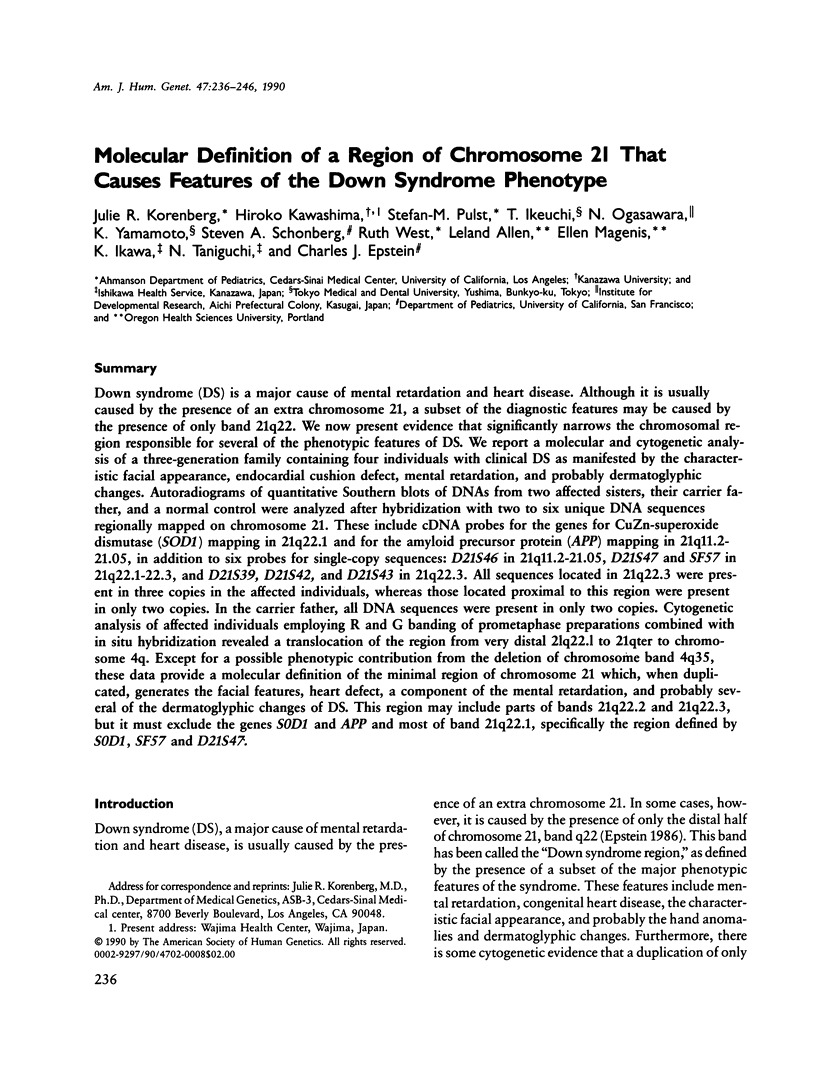
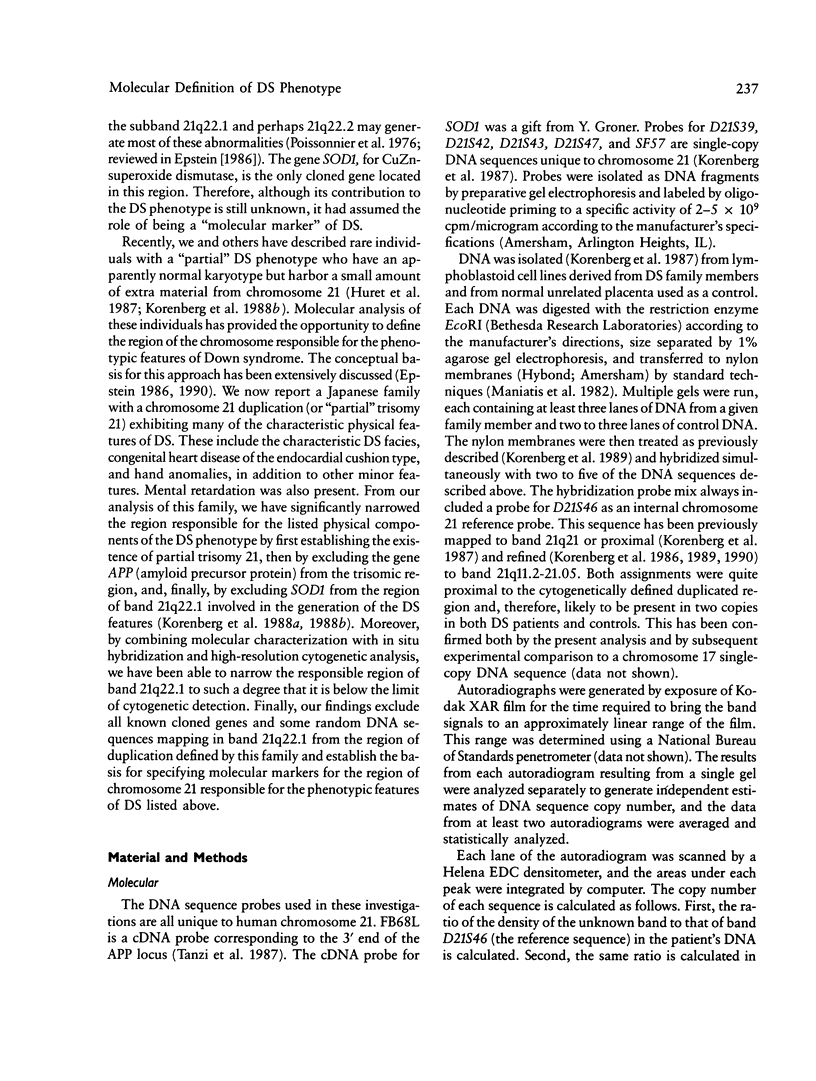
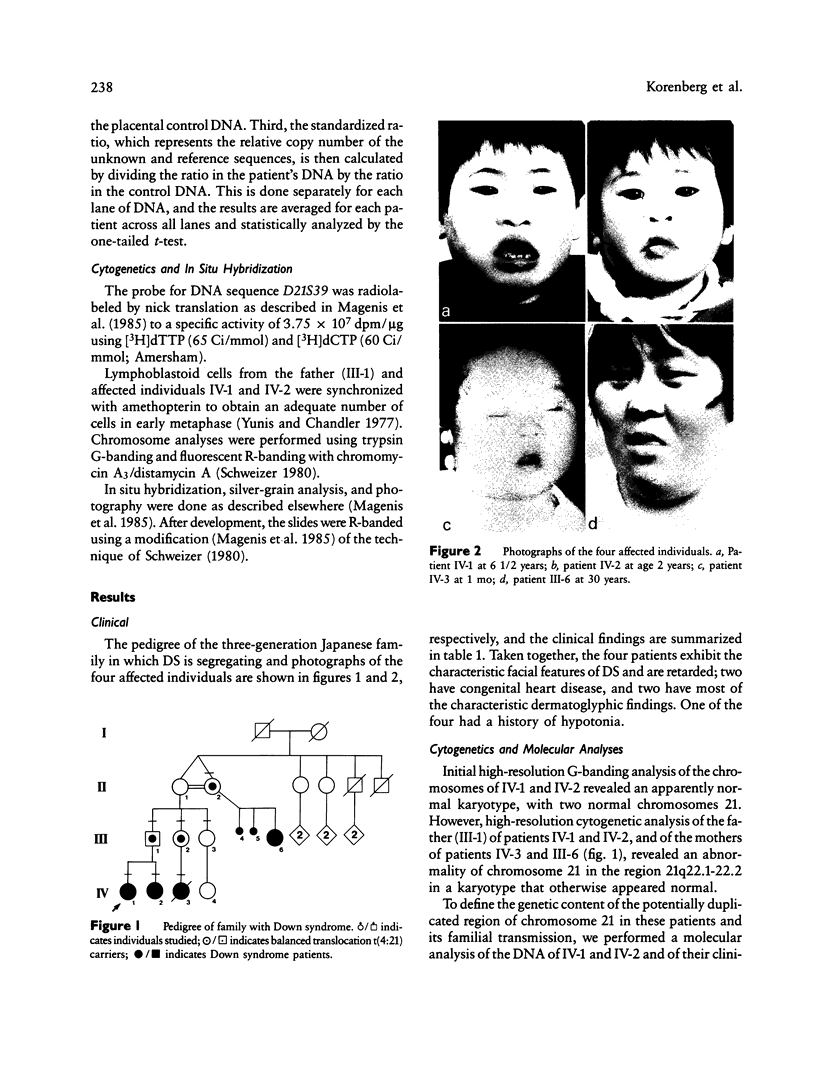
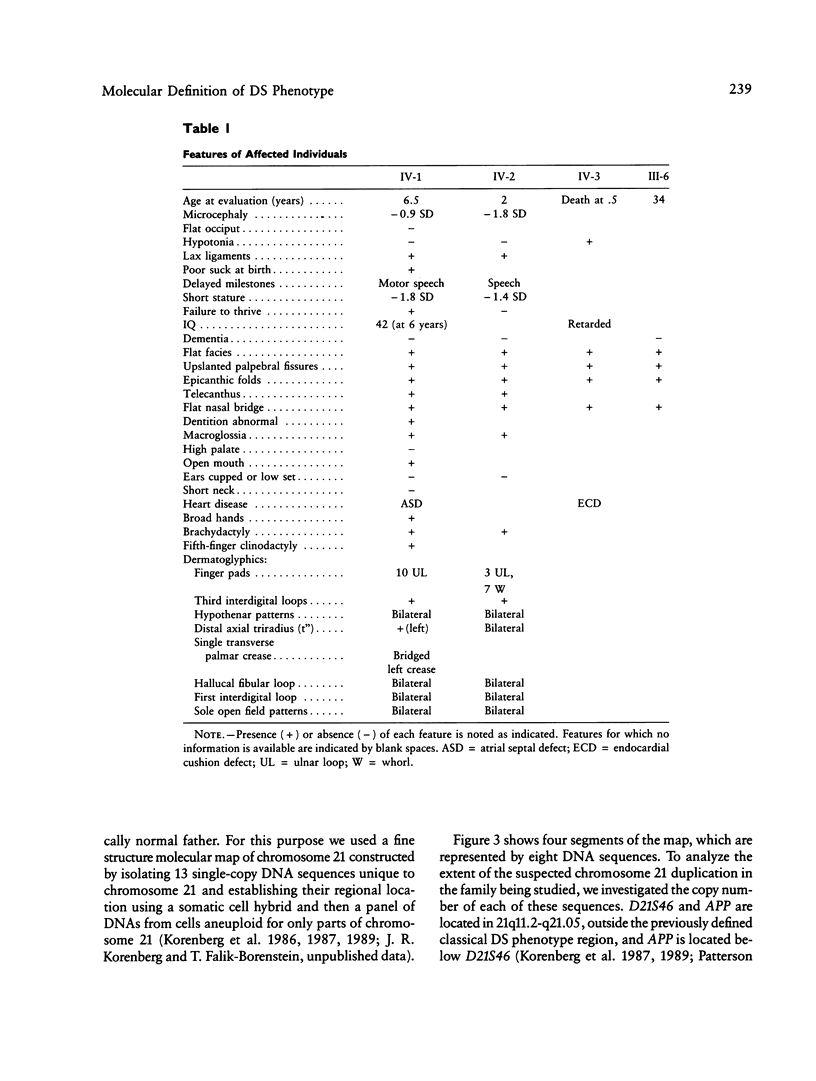

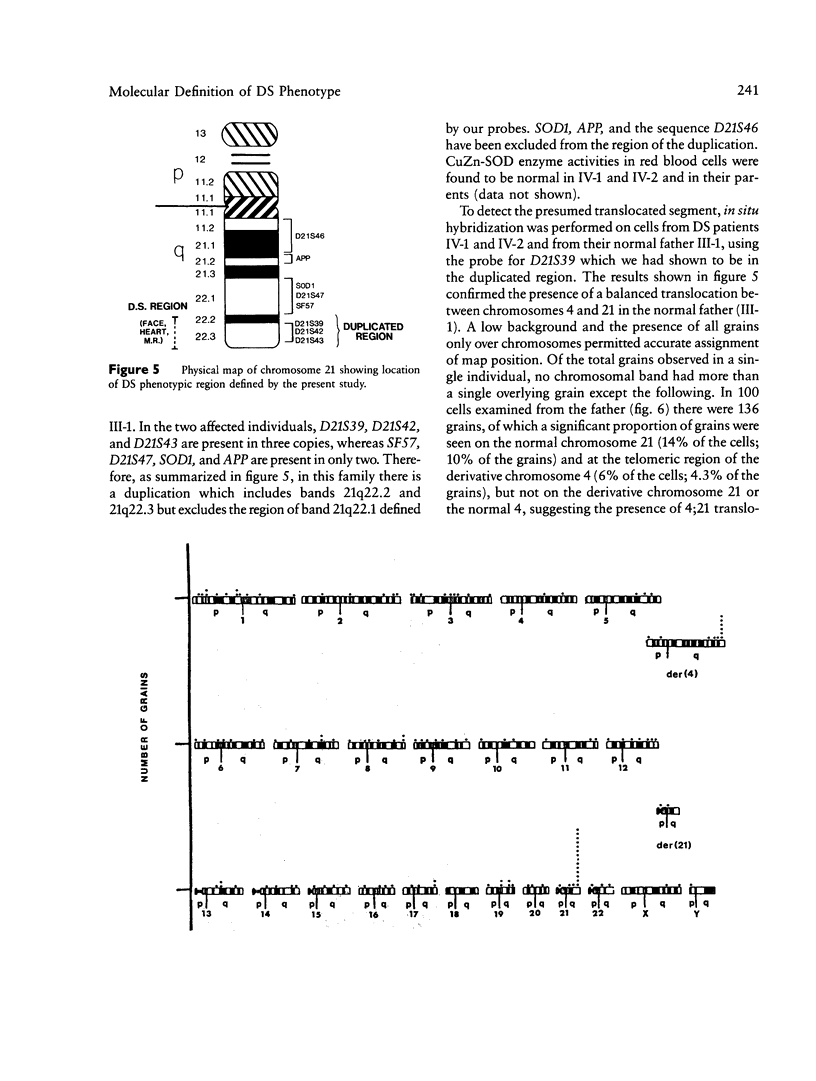

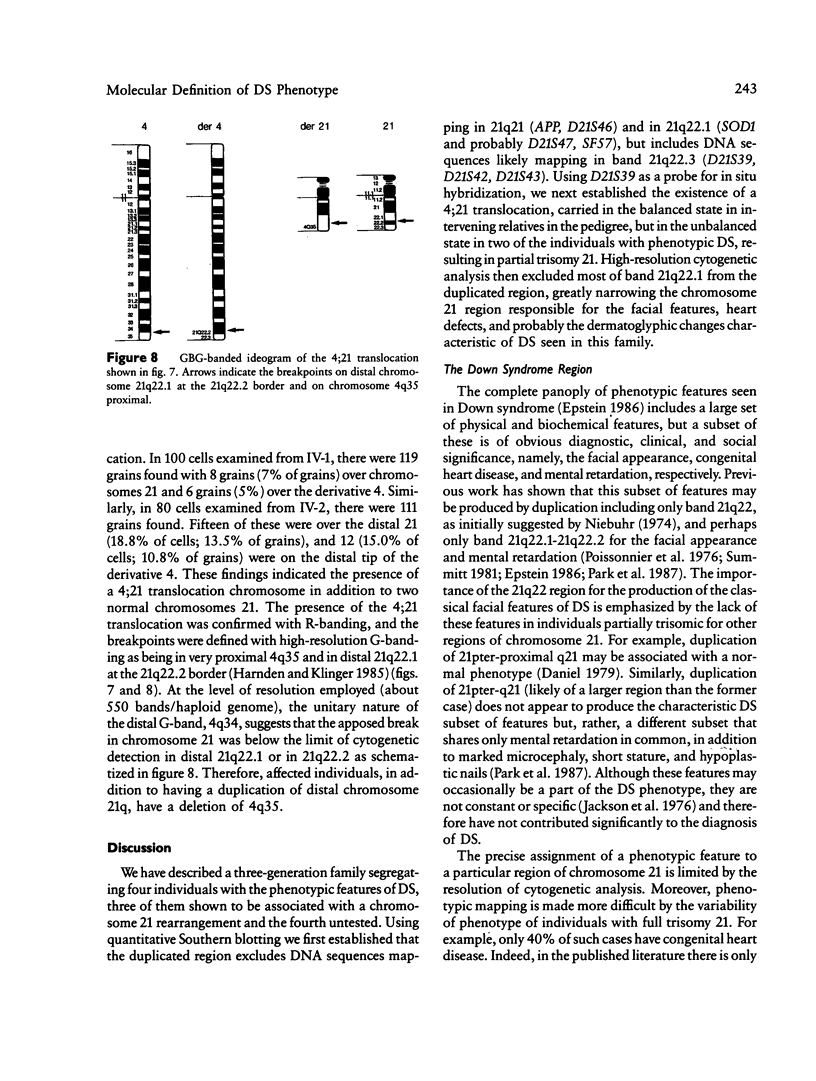
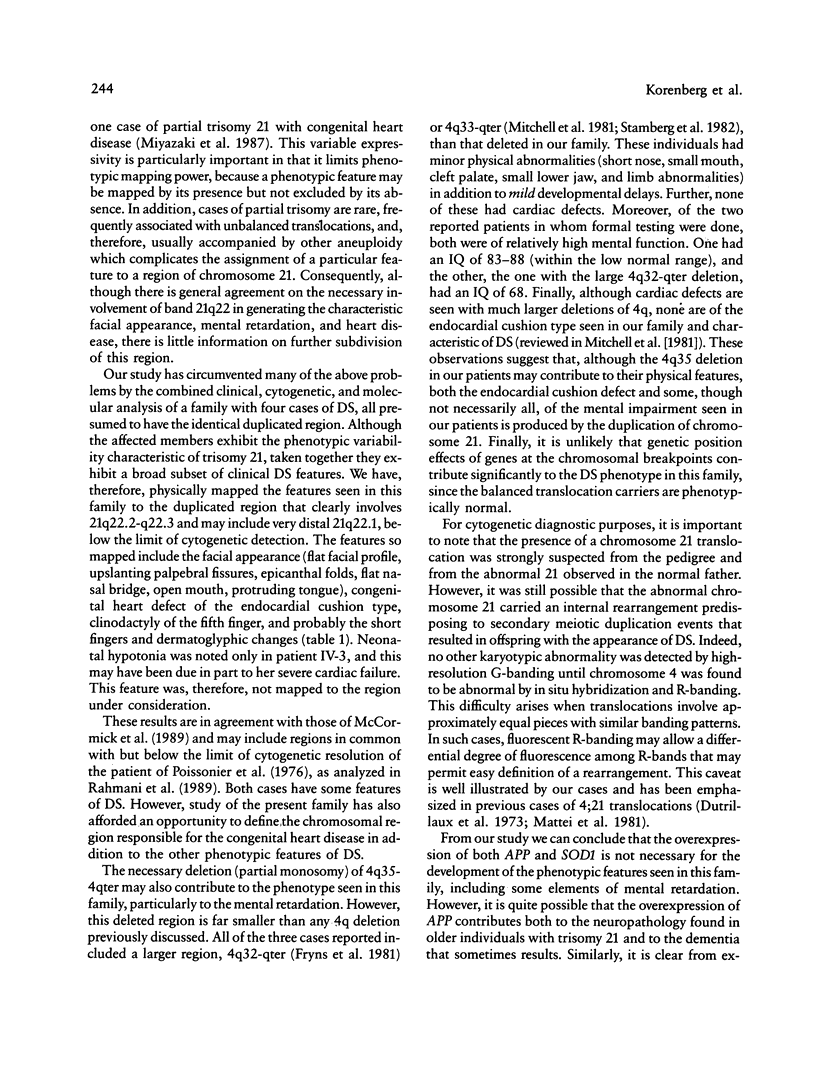
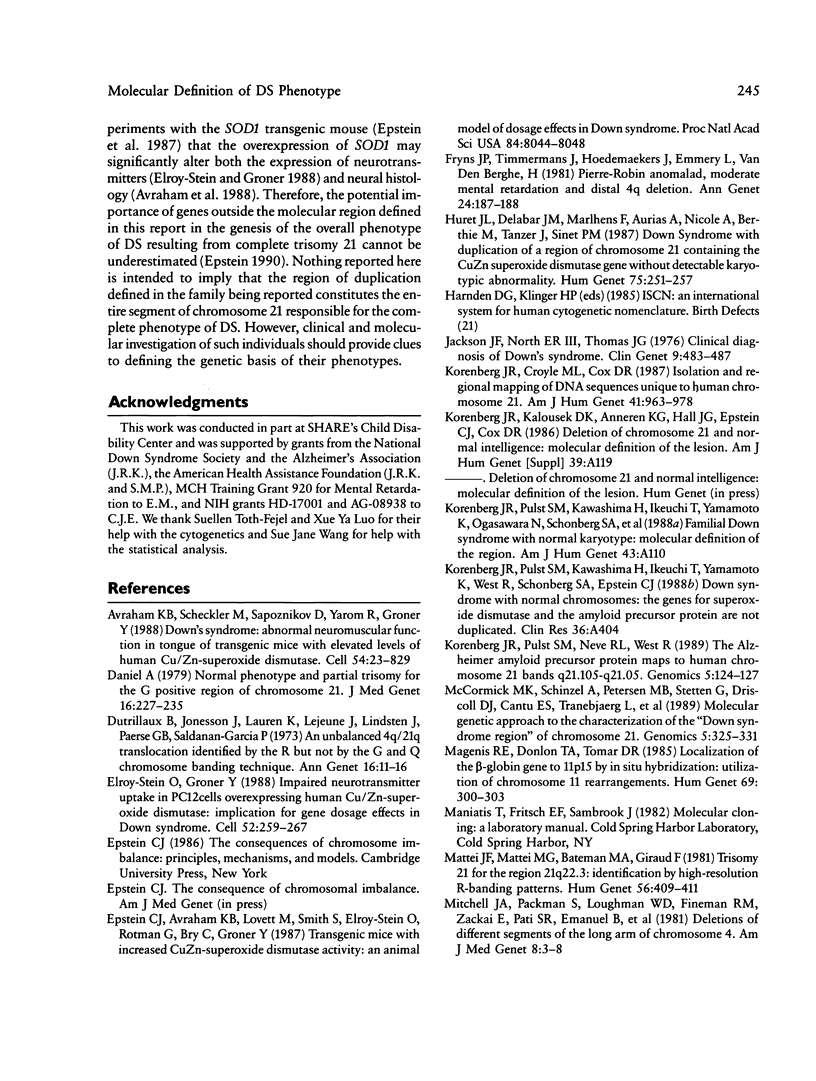
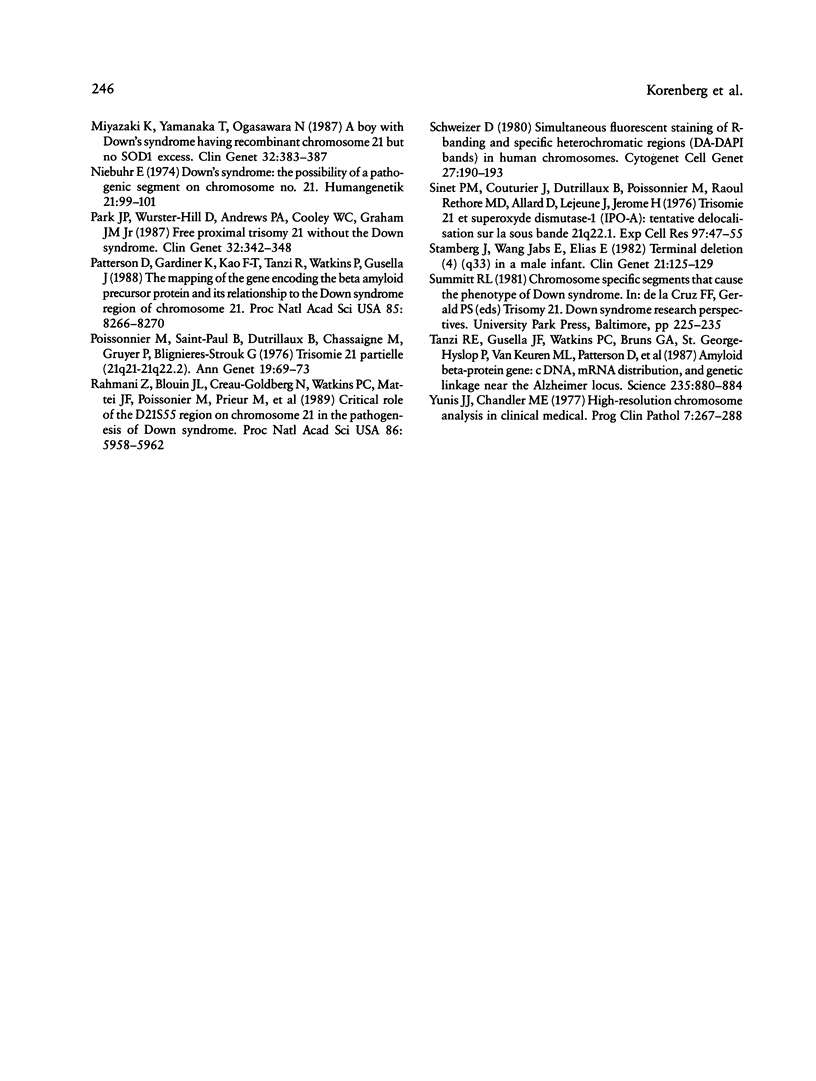
Images in this article
Selected References
These references are in PubMed. This may not be the complete list of references from this article.
- Avraham K. B., Schickler M., Sapoznikov D., Yarom R., Groner Y. Down's syndrome: abnormal neuromuscular junction in tongue of transgenic mice with elevated levels of human Cu/Zn-superoxide dismutase. Cell. 1988 Sep 9;54(6):823–829. doi: 10.1016/s0092-8674(88)91153-1. [DOI] [PubMed] [Google Scholar]
- Daniel A. Normal phenotype and partial trisomy for the G positive region of chromosome 21. J Med Genet. 1979 Jun;16(3):227–229. doi: 10.1136/jmg.16.3.227. [DOI] [PMC free article] [PubMed] [Google Scholar]
- Dutrillaux B., Jonasson J., Laurèn K., Lejeune J., Lindsten J., Petersen G. B., Saldaña-Garcia P. An unbalanced 4q-21q translocation identified by the R but not by the G and Q chromosome banding techniques. Ann Genet. 1973 Mar;16(1):11–16. [PubMed] [Google Scholar]
- Elroy-Stein O., Groner Y. Impaired neurotransmitter uptake in PC12 cells overexpressing human Cu/Zn-superoxide dismutase--implication for gene dosage effects in Down syndrome. Cell. 1988 Jan 29;52(2):259–267. doi: 10.1016/0092-8674(88)90515-6. [DOI] [PubMed] [Google Scholar]
- Epstein C. J., Avraham K. B., Lovett M., Smith S., Elroy-Stein O., Rotman G., Bry C., Groner Y. Transgenic mice with increased Cu/Zn-superoxide dismutase activity: animal model of dosage effects in Down syndrome. Proc Natl Acad Sci U S A. 1987 Nov;84(22):8044–8048. doi: 10.1073/pnas.84.22.8044. [DOI] [PMC free article] [PubMed] [Google Scholar]
- Fryns J. P., Timmermans J., Hoedemaekers J., Emmery L., Van den Berghe H. Pierre-Robin anomalad, moderate mental retardation and distal 4q deletion. Ann Genet. 1981;24(3):187–188. [PubMed] [Google Scholar]
- Huret J. L., Delabar J. M., Marlhens F., Aurias A., Nicole A., Berthier M., Tanzer J., Sinet P. M. Down syndrome with duplication of a region of chromosome 21 containing the CuZn superoxide dismutase gene without detectable karyotypic abnormality. Hum Genet. 1987 Mar;75(3):251–257. doi: 10.1007/BF00281069. [DOI] [PubMed] [Google Scholar]
- Jackson J. F., North E. R., 3rd, Thomas J. G. Clinical diagnosis of Down's syndrome. Clin Genet. 1976 May;9(5):483–487. doi: 10.1111/j.1399-0004.1976.tb01601.x. [DOI] [PubMed] [Google Scholar]
- Korenberg J. R., Croyle M. L., Cox D. R. Isolation and regional mapping of DNA sequences unique to human chromosome 21. Am J Hum Genet. 1987 Dec;41(6):963–978. [PMC free article] [PubMed] [Google Scholar]
- Korenberg J. R., Pulst S. M., Neve R. L., West R. The Alzheimer amyloid precursor protein maps to human chromosome 21 bands q21.105-q21.05. Genomics. 1989 Jul;5(1):124–127. doi: 10.1016/0888-7543(89)90095-5. [DOI] [PubMed] [Google Scholar]
- Magenis R. E., Donlon T. A., Tomar D. R. Localization of the beta-globin gene to 11p15 by in situ hybridization: utilization of chromosome 11 rearrangements. Hum Genet. 1985;69(4):300–303. doi: 10.1007/BF00291645. [DOI] [PubMed] [Google Scholar]
- Mattei J. F., Mattei M. G., Baeteman M. A., Giraud F. Trisomy 21 for the region 21q223: identification by high-resolution R-banding patterns. Hum Genet. 1981;56(3):409–411. doi: 10.1007/BF00274703. [DOI] [PubMed] [Google Scholar]
- McCormick M. K., Schinzel A., Petersen M. B., Stetten G., Driscoll D. J., Cantu E. S., Tranebjaerg L., Mikkelsen M., Watkins P. C., Antonarakis S. E. Molecular genetic approach to the characterization of the "Down syndrome region" of chromosome 21. Genomics. 1989 Aug;5(2):325–331. doi: 10.1016/0888-7543(89)90065-7. [DOI] [PubMed] [Google Scholar]
- Miyazaki K., Yamanaka T., Ogasawara N. A boy with Down's syndrome having recombinant chromosome 21 but no SOD-1 excess. Clin Genet. 1987 Dec;32(6):383–387. doi: 10.1111/j.1399-0004.1987.tb03154.x. [DOI] [PubMed] [Google Scholar]
- Niebuhr E. Down's syndrome. The possibility of a pathogenetic segment on chromosome no. 21. Humangenetik. 1974 Jan 22;21(1):99–101. doi: 10.1007/BF00278575. [DOI] [PubMed] [Google Scholar]
- Park J. P., Wurster-Hill D. H., Andrews P. A., Cooley W. C., Graham J. M., Jr Free proximal trisomy 21 without the Down syndrome. Clin Genet. 1987 Nov;32(5):342–348. doi: 10.1111/j.1399-0004.1987.tb03299.x. [DOI] [PubMed] [Google Scholar]
- Patterson D., Gardiner K., Kao F. T., Tanzi R., Watkins P., Gusella J. F. Mapping of the gene encoding the beta-amyloid precursor protein and its relationship to the Down syndrome region of chromosome 21. Proc Natl Acad Sci U S A. 1988 Nov;85(21):8266–8270. doi: 10.1073/pnas.85.21.8266. [DOI] [PMC free article] [PubMed] [Google Scholar]
- Poissonnier M., Saint-Paul B., Dutrillaux B., Chassaigne M., Gruyer P., de Blignières-Strouk G. Trisomie 21 partielle (21q21 leads to 21q22.2) Ann Genet. 1976 Mar;19(1):69–73. [PubMed] [Google Scholar]
- Rahmani Z., Blouin J. L., Creau-Goldberg N., Watkins P. C., Mattei J. F., Poissonnier M., Prieur M., Chettouh Z., Nicole A., Aurias A. Critical role of the D21S55 region on chromosome 21 in the pathogenesis of Down syndrome. Proc Natl Acad Sci U S A. 1989 Aug;86(15):5958–5962. doi: 10.1073/pnas.86.15.5958. [DOI] [PMC free article] [PubMed] [Google Scholar]
- Schweizer D. Simultaneous fluorescent staining of R bands and specific heterochromatic regions (DA-DAPI bands) in human chromosomes. Cytogenet Cell Genet. 1980;27(2-3):190–193. doi: 10.1159/000131482. [DOI] [PubMed] [Google Scholar]
- Sinet P. M., Couturier J., Dutrillaux B., Poissonnier M., Raoul O., Rethore M. O., Allard D., Lejeune J., Jerome H. Trisomie 21 et superoxyde dismutase-1 (IPO-A). Tentative de localisation sur la sous bande 21Q22.1. Exp Cell Res. 1976 Jan;97:47–55. doi: 10.1016/0014-4827(76)90653-4. [DOI] [PubMed] [Google Scholar]
- Stamberg J., Jabs E. W., Elias E. Terminal deletion(4)(q33) in a male infant. Clin Genet. 1982 Feb;21(2):125–129. doi: 10.1111/j.1399-0004.1982.tb00748.x. [DOI] [PubMed] [Google Scholar]
- Tanzi R. E., Gusella J. F., Watkins P. C., Bruns G. A., St George-Hyslop P., Van Keuren M. L., Patterson D., Pagan S., Kurnit D. M., Neve R. L. Amyloid beta protein gene: cDNA, mRNA distribution, and genetic linkage near the Alzheimer locus. Science. 1987 Feb 20;235(4791):880–884. doi: 10.1126/science.2949367. [DOI] [PubMed] [Google Scholar]
- Yunis J. J., Chandler M. E. High-resolution chromosome analysis in clinical medicine. Prog Clin Pathol. 1978;7:267–288. [PubMed] [Google Scholar]





